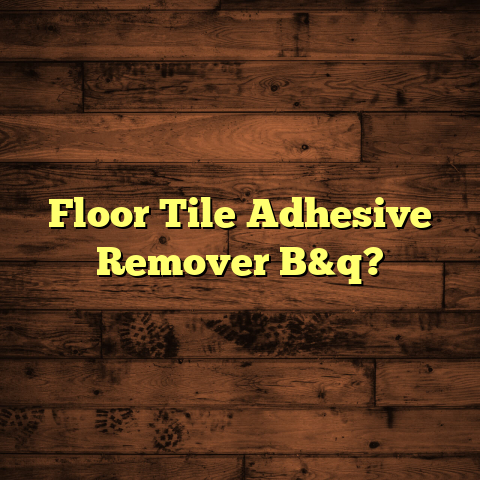Flexible Tile Adhesive Options For Shower Trays? [Quick Guide]
Warmth is a feeling that transcends mere temperature. It can be found in the embrace of a loved one, the glow of a fireplace, or the inviting ambiance of a well-designed bathroom. When I think about warmth in my home, I often envision the soothing touch of a beautifully tiled shower tray. Over the years, I’ve learned that not all adhesives are created equal, and selecting the right one can make a world of difference in both aesthetics and functionality.
The Importance of Choosing the Right Adhesive
Choosing the right adhesive for shower trays is crucial. Moisture is a constant presence in bathrooms, and I’ve seen firsthand how improper installation can lead to costly repairs down the line. Flexible tile adhesives are designed to accommodate slight movements in the substrate and in the tiles themselves, making them ideal for wet areas like showers.
During one of my early projects, I used a standard thin-set mortar for a shower tray installation. While it seemed to hold up initially, within months, I noticed cracks forming around the edges. This experience taught me the importance of flexibility in adhesives. Since then, I’ve always opted for flexible options, ensuring that my clients enjoy both durability and peace of mind.
Types of Flexible Tile Adhesives
Flexible tile adhesives come in various forms, including thin-set mortars, modified thin-sets, and epoxy-based adhesives. Each type has its unique advantages and specific applications. Here’s a closer look at some of the options I’ve encountered over the years:
1. Thin-Set Mortars
Thin-set mortars are a common choice for many flooring contractors. They can be modified to enhance their flexibility and adhesion properties. I’ve used this type on several shower tray installations, and it holds up well under normal conditions.
- Pros: Easy to apply, cost-effective, and versatile.
- Cons: May not perform well in extreme temperature changes or high-moisture environments unless modified.
2. Modified Thin-Set Mortars
Modified thin-set mortars contain additives that improve adhesion and flexibility. They are particularly effective for wet areas like showers. In one project, I used a modified thin-set for a client who wanted a large format tile on their shower tray. The flexibility of the adhesive allowed for slight movements without compromising the bond.
- Pros: Enhanced adhesion, water-resistant, and suitable for large tiles.
- Cons: Slightly more expensive than regular thin-set.
3. Epoxy-Based Adhesives
Epoxy adhesives offer superior strength and moisture resistance. They are ideal for high-traffic areas or when installing heavy tiles. I once had a client who insisted on using marble tiles in their shower. Knowing the weight of marble, I opted for an epoxy-based adhesive to ensure a solid bond.
This tool has been invaluable in providing accurate cost estimates based on local material prices. For example, when I was working on a recent shower installation project, FloorTally helped me calculate the total expenses for both flexible adhesives and tiles.I simply entered the measurements of the shower tray and selected my preferred materials. The software pulled local rates for everything from adhesive to grout. This level of transparency allowed me to present an accurate budget to my client right from the start, building trust and ensuring that there were no surprises down the line.
Installation Process
The installation process can vary depending on the type of adhesive used. However, some steps remain consistent across all flexible tile adhesive applications:
- Surface Preparation: Properly preparing the substrate is key to a successful installation. I always ensure that surfaces are clean, dry, and free from any contaminants.
- Mixing Adhesive: Following manufacturer instructions is essential when mixing adhesive. For modified thin-set mortars, I usually let them slake for about 10 minutes before re-mixing.
- Applying Adhesive: Using a notched trowel, I apply an even layer of adhesive to the substrate. For larger tiles, I often use a larger notch size to ensure adequate coverage.
- Setting Tiles: After applying the adhesive, I press the tiles firmly into place. This is where I usually remind myself to check for levelness as I go along.
- Grouting: Once the tiles are set and cured according to the adhesive’s specifications, grouting comes next. It’s important to choose a grout that complements both the tile and adhesive used.
Challenges Faced
With every project comes its own set of challenges. During one installation, I miscalculated the amount of adhesive needed due to an unexpected change in tile size. This error led to delays while I ordered more material—a costly mistake that could have been avoided with better planning.
Another challenge I faced was moisture seeping through grout lines when using a less flexible adhesive in a high-moisture environment. This led to mold growth behind the tiles, requiring extensive repairs. Since then, I’ve learned to never cut corners on adhesive quality for wet areas.
Tips for Success
Here are some tips I’ve gathered over the years to ensure successful installations:
- Choose Quality Over Cost: Invest in high-quality flexible adhesives tailored for showers. The initial cost may be higher, but it saves money on repairs later.
- Follow Manufacturer Instructions: Each product has specific guidelines for mixing and application—adhere to these for best results.
- Plan Ahead: Always measure twice and plan your materials carefully to avoid mid-project surprises.
- Consider Climate Conditions: If you’re working in an area with extreme temperatures or humidity levels, choose adhesives designed for those conditions.
Maintenance Tips
Once your shower tray is installed, regular maintenance is key to preserving its beauty and functionality:
- Seal Grout Lines: Applying a grout sealer can help protect against moisture intrusion.
- Regular Cleaning: Use non-abrasive cleaners to avoid damaging tiles or grout lines.
- Inspect Regularly: Keep an eye out for any signs of wear or damage; catching issues early can prevent more extensive repairs later on.
Comparing Flexible Adhesive Options
When deciding on which flexible tile adhesive to use, comparing different options can help inform your choice based on specific project needs:
Performance
The performance of an adhesive is often reflective of its composition. For instance, modified thin-set mortars generally outperform traditional thin-set in wet environments due to their enhanced adhesion properties. In contrast, epoxy-based adhesives excel in high-stress situations like heavy tile installations due to their durability.
Application Ease
Some adhesives are easier to work with than others. Thin-set mortars are typically simple to mix and apply, making them great for both beginners and seasoned pros alike. On the other hand, epoxy adhesives can be tricky; they require careful mixing and fast application due to their quick curing times.
Cost
Cost is a significant factor in any project. While epoxy adhesives provide excellent performance characteristics, their prices are higher than those of thin-set options. Modified thin-set mortars strike a balance between cost and performance—making them a popular choice among contractors like myself.
Personal Anecdotes
Reflecting on my experiences with flexible tile adhesives brings back memories of various projects that shaped my understanding of this important aspect of flooring installation.
One memorable project was a luxury home renovation where I was tasked with tiling an expansive walk-in shower with large porcelain tiles. My client wanted everything done perfectly since it was a centerpiece of their new bathroom design. I opted for modified thin-set mortar due to its flexibility and strength—an excellent choice given the sheer size of the tiles.
As I began setting the tiles, I could see how well the adhesive worked under pressure; it held firm even as I moved around in tight spaces trying to get everything just right. In this case, investing time and money into quality adhesive paid off tremendously when my client praised not only the beautiful finish but also how well everything held up over time.
Another project taught me about testing new products on smaller jobs before making larger commitments. I had heard about a new type of flexible adhesive that promised exceptional water resistance but was unproven in actual installations. Eager to try it out on a small bathroom remodel before recommending it widely, I went ahead with my instincts.
The results were less than ideal; while adhesion was decent during application, several weeks later my client reported issues with tiles lifting along the edges due to moisture infiltration beneath them—clearly indicating this product wasn’t ready for prime-time use yet! A lesson learned: always test before going all-in on new materials!
Technical Specifications
Understanding technical specifications is essential when choosing flexible tile adhesives:
- Shear Strength: This measures an adhesive’s ability to resist shear forces once cured. Most modified thin-sets have shear strengths exceeding 1,000 psi (pounds per square inch), making them suitable for most residential applications.
- Moisture Resistance: This refers to how well an adhesive performs when exposed to moisture over time. Epoxy adhesives typically have superior moisture resistance compared to modified thin-set mortars.
- Cure Time: Knowing how long an adhesive takes to cure is crucial for project timelines. While thin-set mortars may require 24 hours before grouting, some epoxy options can set within hours—but require careful management during application due to their quick curing nature.
The Future of Tile Adhesives
As technology evolves, so do tile adhesives. New formulations are being developed that offer even greater flexibility and moisture resistance while also being eco-friendly.
I recently attended a trade show where several manufacturers showcased innovative products made from sustainable materials without compromising performance characteristics—an exciting development! These advancements promise to make our industry more sustainable while still delivering top-tier results for clients’ homes.
Concluding Thoughts
In my experience as a flooring contractor, choosing the right flexible tile adhesive is crucial for ensuring long-lasting results in shower tray installations. Each option has its pros and cons, but understanding the specific needs of your project will guide you in making informed decisions.
Reflecting on my journeys through various projects, I’ve learned that preparation and knowledge are invaluable assets in our field. Whether you’re tackling a bathroom renovation or simply updating your shower tray, taking time to research your adhesive options can lead to beautiful results that stand the test of time.
With careful planning and attention to detail—plus a little help from tools like FloorTally—you can achieve stunning results that radiate warmth in your home for years to come. Always remember that every project is unique; take pride in finding solutions tailored specifically for each client’s needs!


![Tile Floor For Beginners: Easy Steps [Quick Guide]](https://floortally.com/wp-content/uploads/2025/01/Tile-Floor-For-Beginners-Easy-Steps-Quick-Guide.png)
![Why Do My Floors Squeak? [Quick Fix Guide]](https://floortally.com/wp-content/uploads/2025/01/Why-Do-The-Floors-Squeak-In-My-House.png)

![How Thick Should Your Concrete Basement Floor Be? [Don't Overpay]](https://floortally.com/wp-content/uploads/2025/01/How-Thick-Should-A-Concrete-Basement-Floor-Be.png)
![Quick Fix: How To Touch Up Wood Floors [Fast]](https://floortally.com/wp-content/uploads/2025/01/How-To-Touch-Up-Wood-Floors.png)